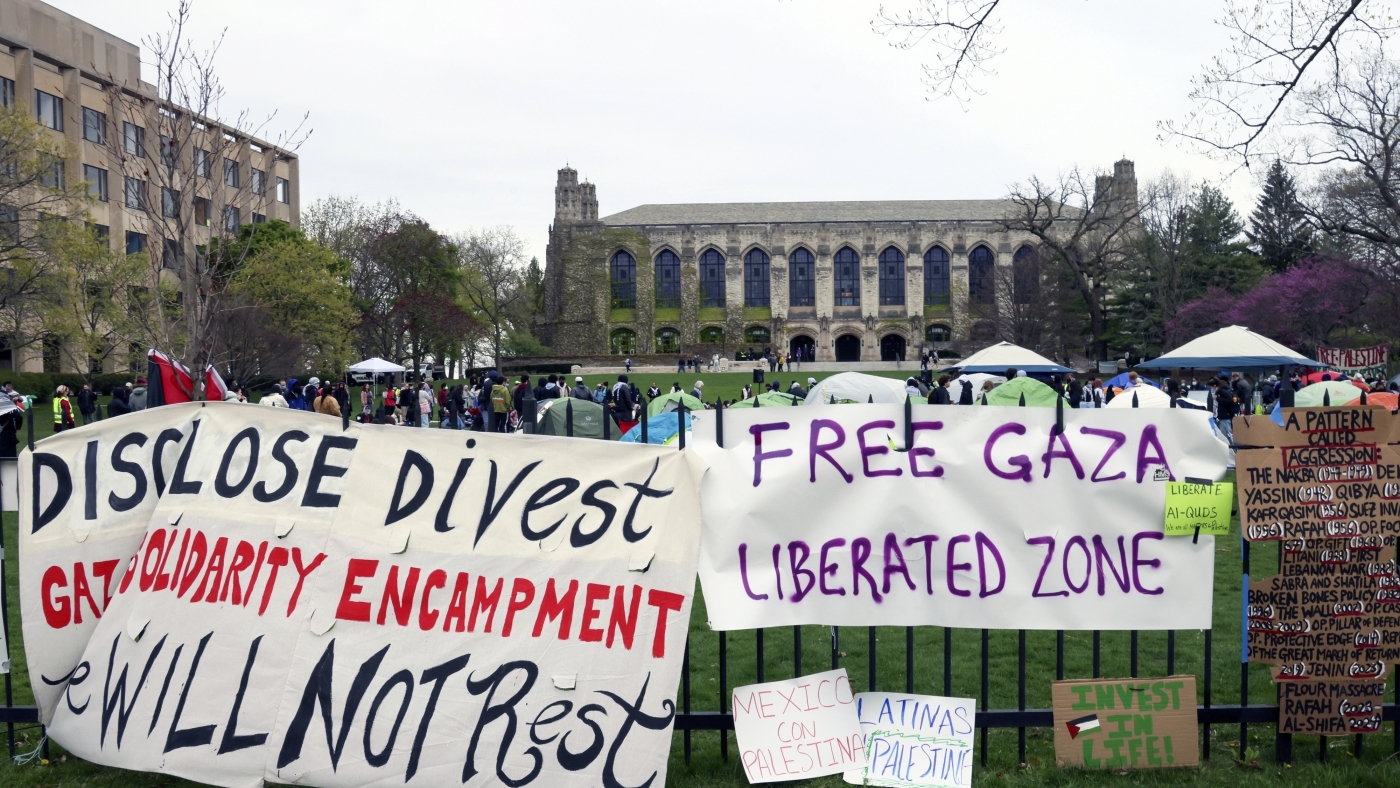Education
Can You Create a Diverse College Class Without Affirmative Action?

After the Supreme Court effectively ended affirmative action in 2023, many selective colleges said they still prized racial diversity and planned to pursue it. But how might they do that?
To grasp the challenge, let’s look at one oversimplified illustration. These 10,000 dots represent the standardized test scores of a class of high school seniors nationwide, arranged by their parents’ income.
On average, students from families with more resources tend to do better on measures like the SAT.
Black and Hispanic students, who tend to be poorer and have less access to opportunity, often do worse.
If selective colleges admitted students by score alone — using, say, a 1300 cutoff — the pool would not be very diverse, by race or class.
Six percent of this hypothetical admitted class are low-income students, and 10 percent are Black or Hispanic.
Affirmative action policies helped colleges admit more Black and Hispanic students.
But admissions preferences based on race are no longer legal. To create a more diverse class, colleges could …
… move that cutoff line …
… or change the slope of it …
… or rethink it entirely.
“Low-income” refers to students in the bottom quarter of parent income distributions.
Selective colleges and universities can no longer use race-based preferences in admissions to create a more diverse student body. But what if they gave a break instead to lower-income students? Or those from high-poverty schools? Or those who do relatively well academically despite challenges all around them?
To explore those questions — and how much racial diversity is possible without “race-conscious” admissions — the Upshot worked with Sean Reardon, a professor at Stanford, and Demetra Kalogrides, a senior researcher there, to model four alternatives to affirmative action.
The scenarios shown here are based on the real-life academic and demographic characteristics of the high school class of 2013 in America, the most recent tracked over time by a large nationally representative survey. We used this data set, further adjusted to reflect the rising diversity of students in the decade since, to simulate a representative class of 10,000 high school seniors. We then modeled their admissions prospects to the group of colleges (Barron’s Tier 1 schools) that rank as the most selective in the country — and that have also been most affected by the Supreme Court’s ruling.
Throughout, we use SAT scores as a simplified measure of academic merit (after test scores fell out of favor with many colleges during the pandemic, several of the most selective schools have recently returned to requiring them).
Our models simplify the complex and often opaque ways that selective colleges craft admissions (we also reserve no seats for athletes on scholarship or legacy students). But even a stripped-down exercise shows why some approaches to admissions would probably yield more diversity than others, by both race and class.
Let’s start with the simplest model and build from there:
Scenario 1 of 4: A preference for poorer students
Here again is our simulated class of 10,000 high school seniors, further identified by race.
Only some apply to the most selective colleges, a relatively small tier of about 80 schools like Stanford, Penn and N.Y.U.
Here’s where the admissions policies kick in. First, we admit 500 students, roughly in line with admissions rates at selective colleges.
Now let’s give a 150-point SAT boost to the lowest-income students.
Use the buttons to explore what happens in this scenario as well as the ones below.
In this scenario, we give a moderate boost to applicants on a sliding scale according to their parents’ income: from an extra 150 points for students from the poorest families, to 0 points for students from the richest ones. This creates the slope of the cutoff line you see above.
Because each of our scenarios admits a fixed class of 500 students, the results are zero-sum: As some students are newly admitted, others who might have been admitted under different policies no longer are. The magnitude of that effect — and whom it touches — differs depending on the criteria.
In this case, as more low-income students are admitted, some high-income students with SAT scores just above 1300 no longer get in. That trade-off creates significantly more economic diversity, as this table shows:
Percentage point shifts in admitted student demographics, compared with test-only admissions
Show shares
Figures are rounded. Other includes American Indian, Alaska Native and multi-racial students.
Change in admitted class in Scenario 1
Race
Bottom 25%
25th–
50th50th–
75thTop
25%
White
–
–
–
–
Asian
–
–
–
–
Black
–
–
–
–
Hispanic
–
–
–
–
Other
–
–
–
–
The share of admitted students from the top income quartile falls by about 12 percentage points.
But the shifts toward racial diversity are modest. The Black student share rises by just one percentage point. Why? Black families are over-represented among poorer households in America, but in terms of total numbers, there are still many more poorer white households.
For this reason, income is a relatively weak proxy for race in admissions. A preference for lower incomes produces just that: students with lower incomes, not necessarily a much larger share of Black or Hispanic students.
In this scenario, a total of 13 percent of students in the admitted class are Black or Hispanic. For context, Americans of high-school-graduation age today are about 38 percent Black or Hispanic.
It’s also worth emphasizing that we are modeling who gets admitted, not who enrolls. And Black and Hispanic students are less likely to take that additional step — enrolling in a selective college that might be expensive or far from home, even if they get in.
Scenario 2 of 4: Adding school poverty
In addition to a preference for low-income students, what if we added a preference for those who attend higher poverty schools?
Admit students using …
This scenario takes the 150-point income preference in Scenario 1 and adds a second 150-point preference for students in higher-poverty schools, as measured by the share of students in that school receiving free or reduced-price lunch. A low-income student in a high-poverty school could get as much as a 300-point boost.
This produces even more economic diversity than the preference for parental income alone. And it further nudges up the share of admitted Black and Hispanic students.
Change in admitted class in Scenario 2
Percentage point shifts in admitted student demographics, compared with test-only admissions
Show shares
| Race | Bottom 25% | 25th– 50th |
50th– 75th |
Top 25% |
|---|---|---|---|---|
| White | – | – | – | – |
| Asian | – | – | – | – |
| Black | – | – | – | – |
| Hispanic | – | – | – | – |
| Other | – | – | – | – |
Figures are rounded. Other includes American Indian, Alaska Native and multi-racial students.
We know that students with equally low family incomes differ from each other in many ways. For example, low-income Black and Hispanic students are more likely than low-income white and Asian students to live in high-poverty neighborhoods and attend high-poverty schools.
And so if one goal of an admissions policy is to account for the compound disadvantages minority students often face, it may help to pull in more information: not just about their parents’ incomes, but also about their households, schools and neighborhoods.
Colleges could further hone a preference like this by pulling in more factors, including neighborhood poverty rates, parental education levels and parental wealth.
Do something like that, and “now you have a group of students who have overcome a lot more in life than the ones who have just been handed everything,” said Richard Kahlenberg, a researcher at the Progressive Policy Institute who has argued for this kind of robust class preference. He also served as an expert witness critiquing race-based admissions in the litigation that led to the Supreme Court decision.
Scenario 3 of 4: Finding the outliers
It’s possible to take the underlying idea in Scenario 2 and dial it up further, by identifying students who outperform their peers with similar disadvantages (or similar advantages).
Admit students using …
Here, we’re not just giving a boost to students who come from disadvantage. We’re rewarding students who perform better academically than other students with similar backgrounds.
This strategy identifies, for example, a student who has an 1100 SAT score — but whose score is 250 points above the typical student who also goes to a high-poverty high school and who has low-income parents who didn’t attend college. This strategy also discounts some of the wealthiest students whose 1400 scores look less impressive when compared with their equally well-off peers.
Students who outperform their peers are academic outliers, and that may indicate something special about them: “We’re admitting students on the basis of striving: students whose academic achievement exceeded expectations based on the access to opportunity that they had,” said Zack Mabel, a Georgetown researcher who has modeled admissions scenarios similar in concept to this one.
Of the scenarios tested so far, this one does the most to produce both economic and racial diversity, compared with admitting students on test scores alone. It also produces significant shifts among high-income white students; their share of the admitted class is 27 percentage points lower than it would be in a test-only environment. The resulting average SAT score of the admitted class is also the lowest of the scenarios so far, at 1340.
Change in admitted class in Scenario 3
Percentage point shifts in admitted student demographics, compared with test-only admissions
Show shares
| Race | Bottom 25% | 25th– 50th |
50th– 75th |
Top 25% |
|---|---|---|---|---|
| White | – | – | – | – |
| Asian | – | – | – | – |
| Black | – | – | – | – |
| Hispanic | – | – | – | – |
| Other | – | – | – | – |
Figures are rounded. Other includes American Indian, Alaska Native and multi-racial students.
To gauge how we’d expect students to perform in this scenario, we take into account their parental income, school poverty level and a socioeconomic index that includes parents’ education levels and occupations. We use that data to predict each student’s SAT score. Then we admit the students who outperformed those predictions by the largest margins (until we’ve admitted 500 of them).
A college that cares more about keeping a higher average SAT score could use a limited version of a preference like this one. A school that believes students who beat the odds in high school are likely to succeed in college could embrace a fuller version.
Remember that in this scenario and each of the preceding ones, we’ve considered only students who apply to highly selective colleges (the national study we use as a reference shows which students actually did). We have effectively ignored all of the students shown below who don’t apply, including some with pretty good grades and test scores:
Students who didn’t apply to top colleges
Next, let’s think about that group, too.
Scenario 4 of 4: Casting a wider net
What happens when colleges try to expand the applicant pool?
Admit students using …
To create this scenario, we expanded the pool of applicants to selective colleges by modeling a recruiting strategy targeted at predominantly minority high schools.
First, we pull into the applicant pool all students of any race with SAT scores above 1000 at high schools where at least three-quarters of students are nonwhite. Then we rerun the preference for beating the odds from Scenario 3 with this larger applicant pool.
This strategy most notably captures more Hispanic students, and it produces by far the biggest shift toward lower-income students. It broadly redistributes seats held in an SAT-only scenario by high-income white students and, to a lesser degree, high-income Asian ones.
Percentage point shifts in admitted student demographics, compared with test-only admissions
Show shares
Figures are rounded. Other includes American Indian, Alaska Native and multi-racial students.
Change in admitted class in Scenario 4
Race
Bottom 25%
25th–
50th50th–
75thTop
25%
White
–
–
–
–
Asian
–
–
–
–
Black
–
–
–
–
Hispanic
–
–
–
–
Other
–
–
–
–
Although colleges can no longer employ racial preferences in admissions, several legal scholars said they believe schools can still consider race in recruiting strategies. The Supreme Court, in turning away another recent legal challenge, has also signaled — at least for now — that it’s permissible for colleges to pursue diversity as an end goal so long as racial preferences aren’t the means to achieve it.
Of the scenarios we’ve shown, an expanded recruiting strategy requires the most work from colleges. But it’s also “the big overlooked gold mine here,” said Richard Sander, a law professor at U.C.L.A. who has worked on admissions strategies at the law school level.
Such a recruiting strategy would mean not just tweaking statistical preferences, but also building relationships with high school counselors, traveling to college fairs, and perhaps developing dual-enrollment courses that introduce high school students to college work.
This kind of outreach — “to me, it’s everything,” said Jill Orcutt, the global lead for consulting with the American Association of Collegiate Registrars and Admissions Officers. She was previously the associate vice chancellor for enrollment at U.C. Merced, the most diverse school in the University of California system.
Comparing our scenarios
In evaluating the impact of the scenarios shown here, we’ve compared each one with the SAT-only baseline in which colleges consider a form of academic merit and nothing else. But it’s also helpful to think about these scenarios in another way — in comparison to the world as it might look if affirmative action were still legal.
To make that comparison, we also created a model approximating the effects of affirmative action. We took the same 150-point boost we’ve used in earlier scenarios, and we applied it to Black and Hispanic students. Real-world affirmative action policies were more complicated than this. But studies have found that such policies gave Black and Hispanic students higher odds of admission equivalent to an SAT score boost of a few hundred points.
Across all our models, Scenario 4 — rewarding students who are academic outliers given their life circumstances, while targeting a wider pool of recruits — comes the closest to creating the Black and Hispanic student shares you might get by giving a boost directly to those students:
“Low-income” refers to students in the bottom quarter of parent income distributions. Figures are rounded and show the share of students who are admitted in each of our models, under simplified assumptions.Black and Hispanic students in each scenario
Alternatives to affirmative action
Other comparisons
Low-income students in each scenario
Alternatives to affirmative action
Other comparisons
Notably, our simple affirmative action model produces far less economic diversity than all of these alternatives. That was also a frequent criticism of such policies: Yes, colleges used them to admit more Black and Hispanic students, but those were overwhelmingly middle- and upper-income students. In our affirmative action model, just 6 percent of admitted students come from the bottom quartile of the income distribution. That’s almost identical to the share of such students who were enrolled in the real world across these selective colleges, according to a 2017 report.
To be clear, our simplified affirmative action model also suggests selective colleges would admit a far higher share of Black and Hispanic students — nearly 34 percent — than were actually in the incoming class of 2022 (23 percent across this top tier of selective schools). That’s because our model captures the upper bound of what’s possible with such a strategy.
Some schools that were already heavily investing in expanded recruiting, like Johns Hopkins, were actually close to or even above this number. Other selective colleges that devoted more seats to legacy students and fewer resources to minority recruiting or financial aid had much lower shares. Our model, in its simplicity, effectively treats all of these varied schools as if they act in unison.
The scenarios illustrated here can’t predict what will happen next — this is a model after all, if one based on real demographics. But this exercise reveals some broad lessons that probably translate to the real world: Income by itself is a weak stand-in for race. Neighborhood and school-level data can help identify minority students. And the potential of any admissions strategy is limited without casting a wider recruiting net.
The questions affecting each admissions parameter are also murky. Does more economic diversity replace some of what colleges lose with less racial diversity? Should students be evaluated in the context of all their disadvantages? How much should colleges yield on lower measures of academic merit to gain the advantages of a diverse campus?
Individual colleges will answer these questions in different ways. And they will do so considering factors, including financial aid and legacy admissions, that are more complex than the ones we modeled. But they’ll also have access to a lot more data than we do about each prospective student in trying to fine-tune what comes next. We will soon see what they do with it.
About this project
The data behind these admissions scenarios comes from the High School Longitudinal Study of 2009, which tracked a nationally representative cohort of over 23,000 U.S. high school students, starting in the ninth grade in 2009. The data collected over time includes high school transcripts, standardized test scores, Advanced Placement exam results, parents’ socioeconomic status and the colleges that students applied to and attended.
In models built with Sean Reardon and Demetra Kalogrides at Stanford, we illustrate 10,000 simulated students, constructed to resemble the demographic and academic makeup of the HSLS cohort in its senior year, 2013. We further weight that group to adjust for the racial diversity of ninth-grade students in America in 2019-20, using the Common Core of Data (for public school students) and the Private School Universe Survey (for private school students). Because we begin our simulations with students in U.S. high schools, our modeled admissions outcomes do not include international students, and we exclude international students from comparisons to the actual enrolled class of 2022 across selective colleges. We constructed standardized test scores for each simulated student using 1) reported SAT scores 2) ACT scores converted to an SAT scale (in cases where an SAT score was not reported) 3) a predicted SAT score constructed using a standardized test given to HSLS study participants, their family income, family socioeconomic status, Advanced Placement courses taken and exams passed, and their high school characteristics.
We used SAT scores for ease of interpretation. But many college admissions offices are moving away from them. And so we also modeled the scenarios here using an academic merit index combining GPAs, Advanced Placement exam results and standardized test scores. Those models produced broadly similar results to the ones shown here.
Our models simulate admissions to Barron’s Tier 1 schools. In their simplicity, our models do not consider students admitted with legacy status or athletic scholarships, and they do not take into account the likely availability of financial aid.

Education
Video: Testing Wool Coats In a Walk-in Fridge

new video loaded: Testing Wool Coats In a Walk-in Fridge

November 24, 2025
Lacey Chabert’s Holiday Tips
0:58
Nyx’s Setting Spray Impressed Us
0:50
Padma Lakshmi’s Spice-Organizing Method
1:16
Inside a Liquidation Warehouse
0:58
Three of the Best Socks We Tried
1:09
We Tested The Viral Bounce Curl Brush
1:06
Latest Video
Visual Investigations
Diary of a Song
Magazine
T Magazine
Op-Docs
Opinion
Middle East Crisis
Advertisement
SKIP ADVERTISEMENT
Education
Video: Justice Dept. Says It Will Investigate U.C. Berkeley Protest

new video loaded: Justice Dept. Says It Will Investigate U.C. Berkeley Protest
By Meg Felling
November 11, 2025
Education
Video: Students Find Hope at This Makeshift School in Gaza

new video loaded: Students Find Hope at This Makeshift School in Gaza

By Ang Li, Nader Ibrahim, Saher Alghorra, Meg Felling and Jon Hazell
November 6, 2025
-

 Science1 week ago
Science1 week agoWashington state resident dies of new H5N5 form of bird flu
-

 Business5 days ago
Business5 days agoStruggling Six Flags names new CEO. What does that mean for Knott’s and Magic Mountain?
-

 Politics2 days ago
Politics2 days agoRep. Swalwell’s suit alleges abuse of power, adds to scrutiny of Trump official’s mortgage probes
-

 Ohio4 days ago
Ohio4 days agoSnow set to surge across Northeast Ohio, threatening Thanksgiving travel
-

 Southeast1 week ago
Southeast1 week agoAlabama teacher arrested, fired after alleged beating of son captured on camera
-

 News1 week ago
News1 week agoAnalysis: Why Democrats are warning about Trump giving illegal orders | CNN Politics
-

 Business1 week ago
Business1 week agoFormer Google chief accused of spying on employees through account ‘backdoor’
-

 Technology3 days ago
Technology3 days agoNew scam sends fake Microsoft 365 login pages












